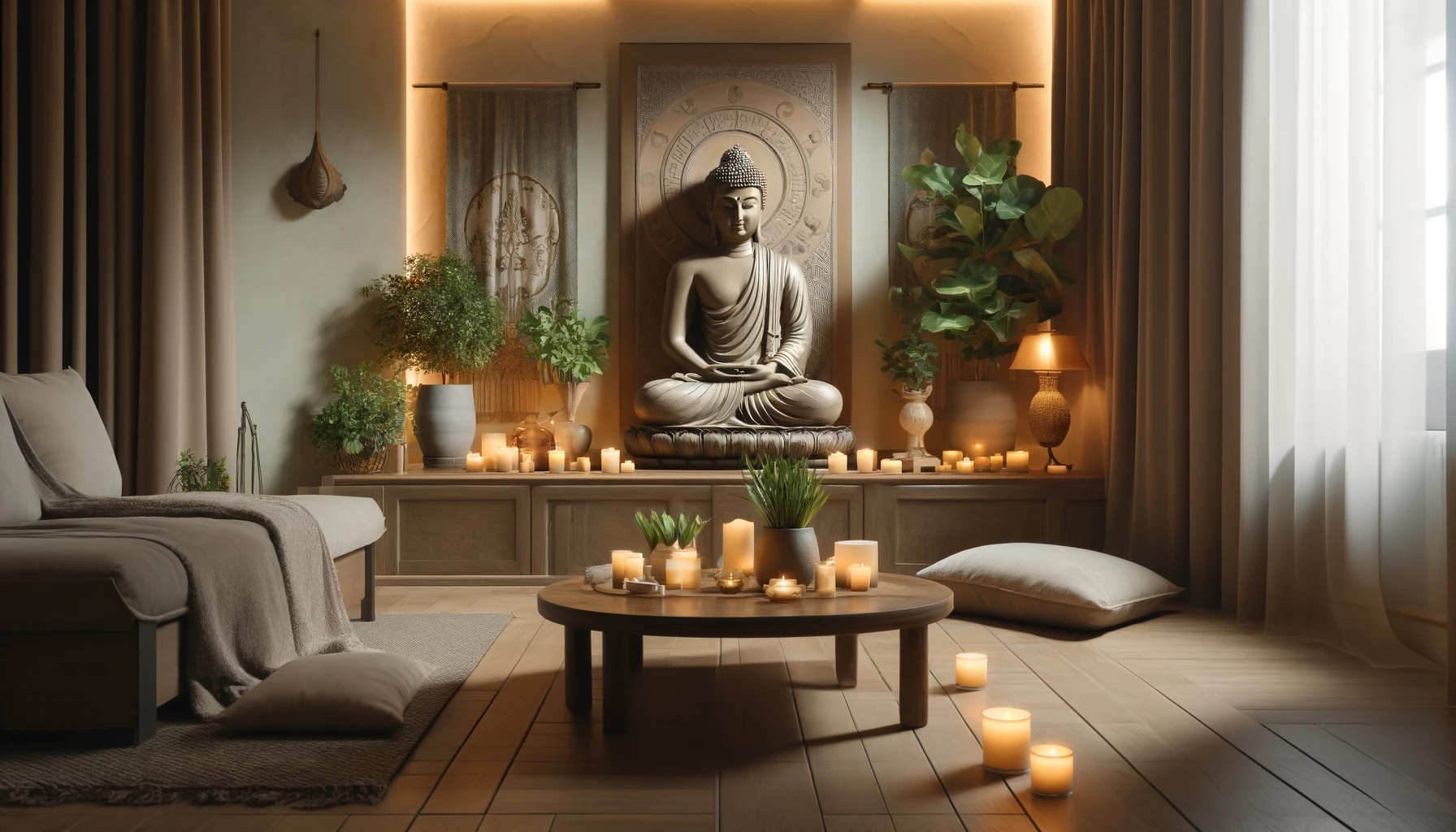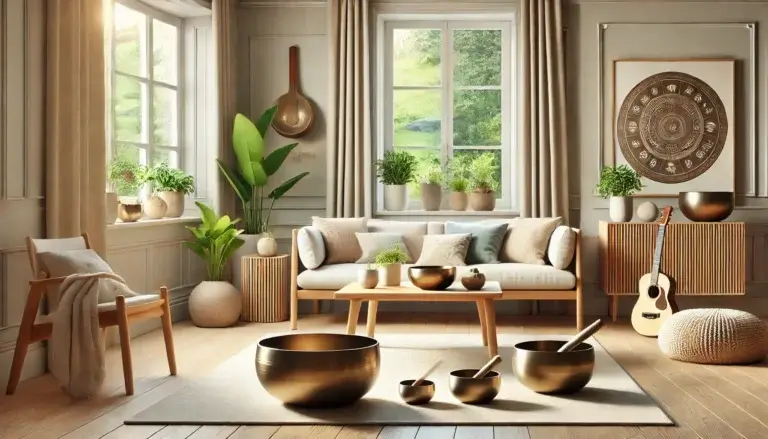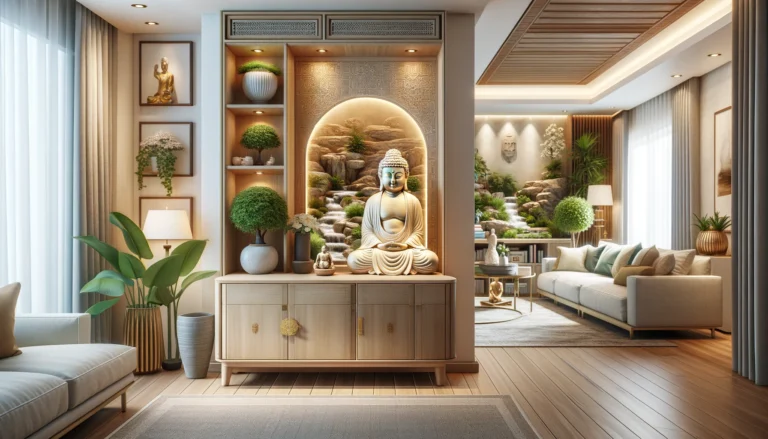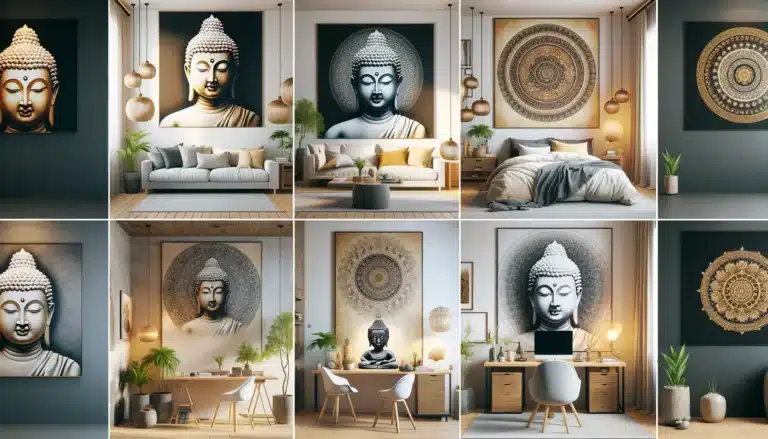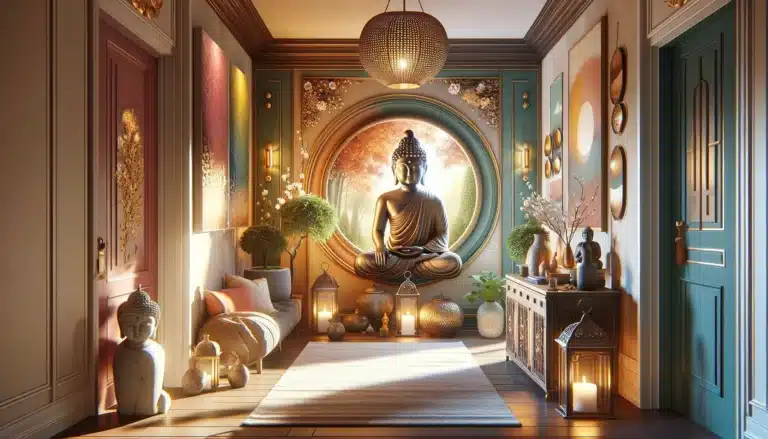Buddha Temple Home Decor for Serene Interiors
buddhaindooroutdoor.com participates in the Amazon Services LLC Associates Program, an affiliate advertising program designed to provide a means for sites to earn advertising fees by advertising and linking to Amazon.com.
Did you know that the principles of Zen Buddhism, emphasizing harmony and tranquility, have influenced interior design for centuries? Today, these time-honored concepts are epitomized in the rising trend of Buddha temple home decor.
By integrating these serene interiors into your living space, you create a personal sanctuary that not only reflects ancient teachings but also offers a peaceful retreat from the hustle and bustle of daily life.
Buddha temple home decor is not just about aesthetic appeal; it’s a journey into crafting a space that embodies tranquility and spirituality.
By choosing the right decorative accents, such as statues, incense holders, and Zen-inspired artwork, you’re invited to imbue your home with a sense of calm that’s both deeply spiritual and refreshingly contemporary.
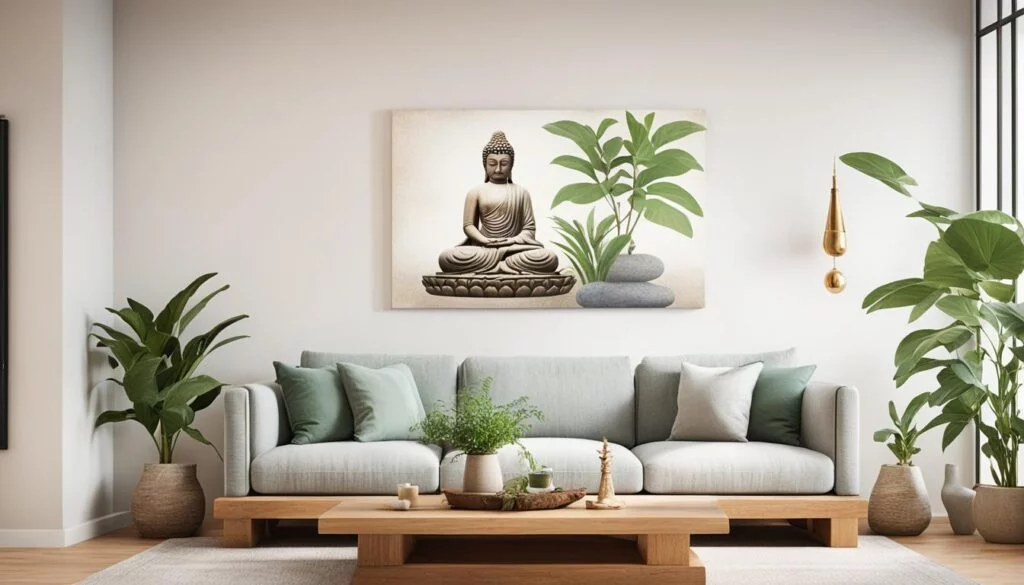
Key Takeaways
- Experience the tranquility of Zen Buddhism through Buddha temple home decor in your own home.
- Transform your living space into a haven of serenity with carefully chosen decorative accents.
- Discover how spiritual elements can complement modern design to create serene interiors.
- Learn the significance of incorporating mindfulness into every aspect of your home decor.
- Embrace the calm and centered lifestyle that Buddha-inspired decor offers.
The Essence of Buddha Temple Home Decor
Within the tranquil spaces of Buddhist temples lies an aura of profound calm and spiritual significance. This essence of Buddha temple home decor stems from its ability to evoke a similar sense of peace and mindfulness with its design elements.
Integrating this decor into your home isn’t just about aesthetics; it’s about creating a sanctuary that anchors you to the present moment, enveloping you in a gentle embrace of serenity.
At the heart of this decorating style are Buddha statues, which serve as a focal point for reflection and inner tranquility. Whether you choose a small, discreet piece or a more dominant sculpture, the presence of such a statue instantly enhances the calmness of your environment.
But the essence of Buddha temple home decor goes beyond mere representations of the Enlightened One. It’s in the soothing scent of burning incense filling the air, in the natural textures and materials like bamboo, and in the symbolically rich lotus flowers that might find a place in your space.
Each of these elements works together to build layers of tranquility, turning your home into a bastion of calm.
Consider how natural elements can be incorporated into your decor. The subtle rustling of bamboo or the serene beauty of a water feature can remind you to slow down and appreciate the intrinsic beauty of nature. These touches of mindfulness provide a backdrop that encourages relaxation and a centered mind.
- Buddha Statues: Place them in areas of rest to invite peace.
- Incense: Use scents like sandalwood or jasmine to purify the space.
- Natural Elements: Incorporate materials like bamboo and stone for their calm-inducing properties.
- Lotus Flowers: Adorn your space with this symbol of purity and enlightenment to encourage positive energy.
Embracing the essence of Buddha temple home decor is about creating an environment that nurtures your spirit, inspires peaceful thoughts, and aligns your home with the meditative qualities of a temple. This decor is not merely what you see but what you feel; a timeless tranquility that resonates in the sanctuary of your own living space.
Incorporating Asian Inspired Home Accents into Your Space
Asian inspired home accents offer an exquisite blend of tradition and modernity, providing a unique way to enhance the aesthetic appeal of your home. These culturally rich accents can infuse your living space with a sense of elegance and worldly sophistication. We’ll delve into how you can integrate these beautiful elements seamlessly with your existing decor, achieving a balance that is both harmonious and striking.
Chinese calligraphy is more than mere writing; it’s an art form steeped in history and significance. When displayed in your home, these intricate characters can serve as a focal point or a subtle nod to Asian culture.
Accompanying these artistic script pieces, consider adding Japanese shoji screens. These elegant dividers not only partition your room but also disperse light softly, creating an ambiance filled with a serene glow.
Korean celadon pottery, known for its delicate green glaze, can be the perfect touch of Asian elegance on a coffee table or shelf. Whether you choose a traditional piece or one with a modern twist, these pottery items are sure to capture attention and spark conversation. With their intricate designs and tranquil aesthetic, they embody the essence of Asian inspired home accents.
To beautifully showcase these accents, consider the aesthetics of placement and arrangement:
- Group items by theme or color for cohesion.
- Balance the space by varying the height and size of objects.
- Position your decor to draw the eye naturally through the room.
Below is a guide to help you introduce Asian inspired home accents into various rooms of your home:
| Room | Asian Accent | Suggested Uses |
|---|---|---|
| Living Room | Chinese Calligraphy Art | Wall centerpiece above the sofa or fireplace |
| Dining Area | Korean Celadon Pottery | Table centerpiece or cabinet display |
| Bedroom | Japanese Shoji Screen | Room divider or decorative headboard |
| Study | Bamboo Plants | Increase tranquility near the workspace |
Remember, incorporating Asian inspired home accents is about creating a space that feels authentic to you. It’s not just about placing objects; it’s about setting a scene that tells a story and reflects your appreciation for Asian culture.
Start with a few key pieces and allow your collection to grow organically. Your home should be a reflection of your personal style, infused with the cultural beauty of Asian design.
As you curate your space with Asian inspired home accents, trust your instincts and enjoy the process of transforming your home into a reflection of worldly elegance and serene ambiance. Whether you’re drawn to the clean lines of a shoji screen or the organic form of celadon, each piece you select is a step towards a home that is both inspired and inspiring.
Crafting a Meditation Room with Decorative Elements
Embarking on the creation of a personal meditation space is a journey towards achieving inner peace and balance. Your attention to detail with meditation room decorations can greatly enhance the experience, inviting a sense of calm from the moment you enter.
Let’s explore how to design a space that not only promotes mindfulness but also resonates with your personal aesthetic.
Designing for Mindfulness and Tranquility
When envisioning your meditation room, consider the power of a minimalist design that allows for clear thought and focus. The colors you choose are foundational – opt for soft, neutral tones that mimic the natural world.
These hues will serve as a soothing backdrop to your meditative practices. Furthermore, incorporating elements such as flowing water features or a collection of smooth, rounded stones can add to the atmosphere of tranquility.
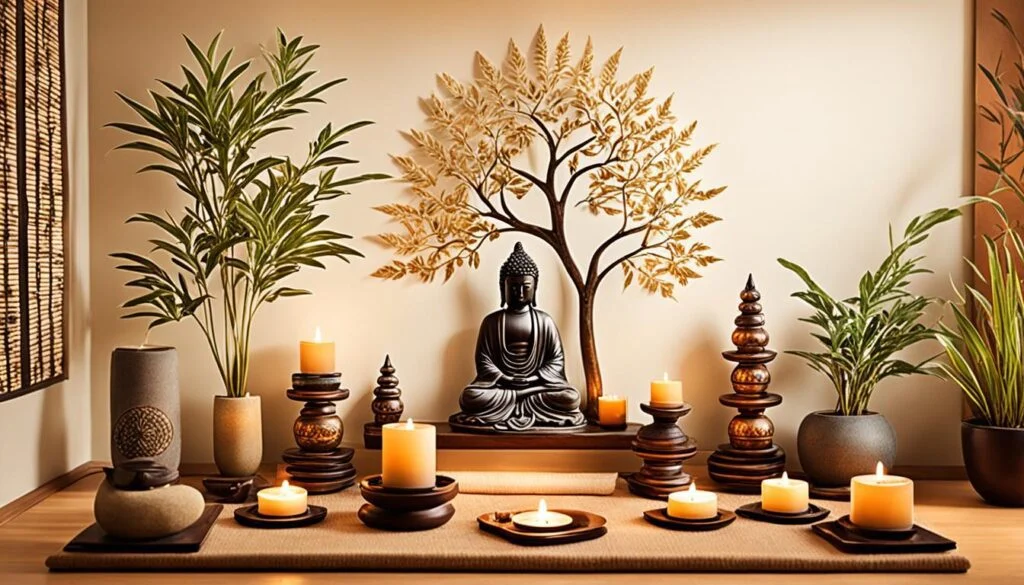
Choosing the Right Meditation Room Decorations
Selecting the appropriate meditation room decorations is crucial for fostering an environment conducive to reflection and peace. Items such as Himalayan salt lamps offer a gentle, warm light source, while incense burners or essential oil diffusers can help engage the senses with calming scents.
Comfort is key, so include plush cushions or a soft mat for seating. The choice of decorations should reflect serenity and simplicity, guiding you naturally into a meditative state upon entering your sacred space.
| Decoration Item | Purpose | Benefit |
|---|---|---|
| Himalayan Salt Lamp | Ambient Lighting | Creates a warm, inviting atmosphere |
| Soft Floor Cushions | Comfortable Seating | Supports prolonged meditation sessions |
| Incense Burner | Aromatherapy | Enhances focus and relaxation |
| Soothing Artwork | Visual Calm | Inspires reflection and tranquility |
| Water Feature | Auditory Calm | Simulates a natural, calming environment |
Your meditation room is a personal retreat, a space that should echo the stillness you seek within. Through careful selection of meditation room decorations, you can create an area that not only serves its purpose but also embodies a sanctuary of your own design. Remember, the simplicity and intentionality behind each element will culminate in the true essence of a serene meditation environment.
Zen Interior Design Tips for a Harmonious Home
Embracing zen interior design is about cultivating spaces that resonate with balance and peace. As we delve into the philosophy of zen, you’ll find that your home can become a sanctuary of elegance and minimalism, an environment where every element has its place and purpose.
Let’s explore how to achieve this equilibrium and why zen aesthetics are more than just a design concept—they’re a lifestyle.
Fusing Simplicity with Elegance
The mastery of zen interior design lies in the ability to blend simplicity with elegance. This approach encourages the use of clean lines and uncluttered spaces.
Consider furniture that boasts simplicity in form and function, opting for pieces that provide comfort without demanding attention. The use of neutral colors and soft textiles can create an environment that calms the senses while still exuding understated sophistication.
Key Components of Zen Decor
At the heart of zen interior design are key components that come together to define the style. Each element, be it a plant, a piece of furniture, or a decorative object, is chosen with intentionality to foster a serene and contemplative space.
Let’s identify these essential components and understand how they contribute to the overall zen aesthetic.
| Natural Elements | Functionality | Visual Harmony |
|---|---|---|
| Wood and stone materials | Minimalist furniture | Balance of shapes |
| Indoor plants like bamboo | Efficient storage solutions | Soft, diffused lighting |
| Water features for tranquility | Space-saving designs | Use of symmetry |
| Textiles that reflect nature | Flexibility in layouts | Muted color palette |
Incorporating these elements isn’t just about appearance; it’s about creating a mindful environment where each piece contributes to your overall well-being. Zen gardens, whether indoor or outdoor, infuse a sense of nature while the natural materials like wood and stone ground the space in the earth’s elements.
The art of de-cluttering goes beyond mere tidiness. It’s about retaining only what serves you, allowing the essential to take precedence and the unnecessary to fall away. Through this purposeful reduction, your home will exude the serenity and poise that zen design stands for.
Embrace zen interior design to transform your living space into a bastion of calm and beauty. Remember, creating a home that feels harmonious is a journey, not a destination.
It’s an ongoing process that adapts and evolves with you. Start by surrounding yourself with elements that embody tranquility and mindfulness, and allow the principles of zen to guide you to a more balanced way of living.
Feng Shui Decor Items for Positive Energy Flow
Incorporating feng shui decor items into your home can significantly affect the energy and balance of your space. These objects are not merely decorations but are believed to attract prosperity, happiness, and tranquility.
By understanding how to place these items thoughtfully, you create an environment where positive energy thrives.
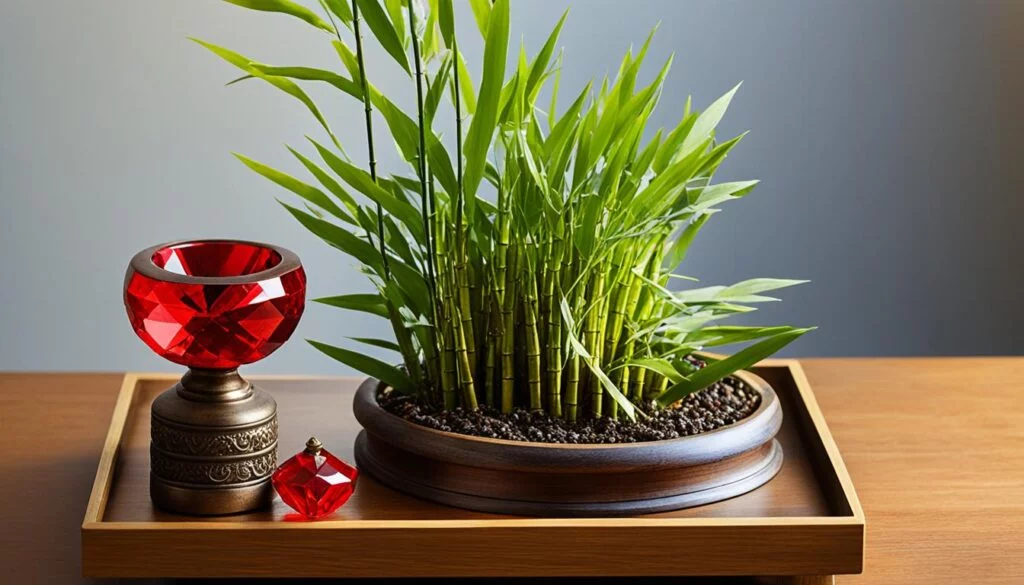
Strategically Placing Buddha Statues
One of the most powerful feng shui decor items is the Buddha statue. Located in the right zone of your home, it can emote spiritual vibrations and a sense of calm. You may position a Buddha facing the front door to welcome positivity or in the meditation space to enhance your reflection practices.
Selecting Colors and Textures for Balance
Selecting the right colors and textures is essential in feng shui. Soft hues like blues and greens promote serenity, while warm colors such as red and orange can generate energy and passion.
Textures also play a part; for example, smooth items might bring a sense of calm, while rough textures can energize a space.
| Item | Placement | Effect |
|---|---|---|
| Buddha Statue | Facing front door | Welcomes positive energy |
| Water Element | Near the entrance | Attracts wealth and opportunities |
| Wooden Elements | East sector for health | Promotes growth and vitality |
| Mirrors | Living area, not facing bed | Expands space and reflects energy |
| Crystals | Window to catch light | Harmonizes energy flow |
As you explore the world of feng shui decor items, be mindful of your intentions and the energy you wish to cultivate. Through feng shui, you can craft a home environment that not only looks beautiful but feels harmoniously balanced and energetically aligned.
Spirituality Home Accessories for Personalized Sacred Spaces
When establishing a space that fosters spiritual growth and inner peace, incorporating spirituality home accessories can significantly enhance the atmosphere. These elements act as conduits for your personal beliefs, imbuing every corner with a sense of tranquility and reflection.
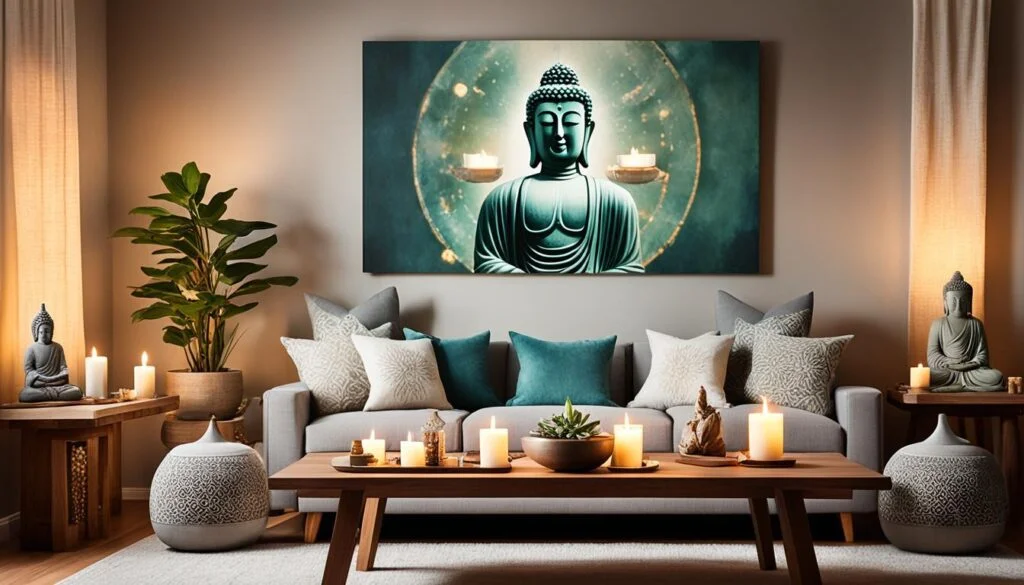
Thoughtfully chosen items like prayer beads or meditation cushions invite a pause for introspection, while affirmation cards lined along a wall can provide daily motivation and encouragement. It’s not simply about decoration; it’s about crafting an environment that resonates with your spiritual frequency.
- Prayer Beads: To center your thoughts during meditation or prayer.
- Affirmation Cards: For daily reminders of your intentions and goals.
- Altar Decorations: Personalize this sacred space with meaningful symbols and icons.
As you select your spirituality home accessories, consider not only their aesthetics but also the energy they carry. Each piece should have a story, a purpose, or a spiritual significance that aligns with your own journey.
Creating a sacred space is a tangible representation of your inner world. It should be a place where your soul feels at home.
Your personal sanctuary is a refuge from the chaos of the external world. With the right spirituality home accessories, this space can become an oasis of clarity and rejuvenation, reminding you of the interconnectedness of all things and the ongoing pursuit of enlightenment.
Eastern Inspired Living Space: Aesthetic and Symbolism
Envisioning an eastern inspired living space isn’t just about decorating with an exotic flair; it’s an immersive experience that interweaves cultural heritage with aesthetic appeal. Integrating elements that resonate with the beauty and philosophies of the East can transform your space into a sanctuary of peace and balance, imbued with deep-seated symbolism and artistic merit.
The Influence of Traditional Eastern Artifacts
Traditional Eastern artifacts carry with them centuries of history, each piece echoing the practices and artistic endeavors of ancient civilizations. For instance, Chinese porcelain vases are not only stunning to look at but offer a narrative of painstaking craftsmanship and storytelling through their intricate patterns.
Japanese folding screens, or Byobu, act as both artistic statements and functional room dividers, featuring scenes that encapsulate the fleeting beauty of nature synonymous with Japanese aesthetics.

Incorporating such timeless pieces creates an anchor for your eastern inspired living space, providing a compelling tale of antiquity that breathes authenticity into modern interiors. Whether displayed prominently or used in daily rituals, these artifacts serve as a bridge between the old and the new, the Eastern philosophy and Western modernity.
Blending Modern and Eastern Decor Styles
Marrying modern elements with Eastern-inspired decor can create a living space that is at once contemporary and steeped in cultural richness. The key lies in finding a harmonious balance where each accent complements the other.
Begin by identifying the core characteristics of your space and then thoughtfully adding Eastern accents that resonate with your aesthetic preferences. This approach not only pays homage to Eastern traditions but infuses your living space with a sense of global sophistication and timeless elegance.
| Modern Design Element | Eastern Inspired Accent | Combined Aesthetic Impact |
|---|---|---|
| Minimalist Furniture | Chinese Porcelain Vase | Clarity of form meets ornate beauty |
| Neutral Color Palette | Indian Silk Pillows | Soothing backdrop highlighted by rich, vibrant textures |
| Industrial Lighting | Japanese Lantern | Edgy illumination softened by a warm, ambient glow |
| Modern Art | Thangka Painting | Abstract expressions complemented by intricate traditional storytelling |
As you embrace the quiet allure of an eastern inspired living space, let each element tell its story, merging timelines and geographies to create a home that stands as both a modern haven and a shrine to artisanship. With each artifact and decor choice, you’re not just transforming a space; you’re celebrating the global tapestry of design.
Mindfulness House Ornaments that Inspire Inner Peace
Incorporating mindfulness house ornaments into your living space can act as potent conduits to serenity, transforming your home into a sanctuary for inner peace.
These ornaments are more than mere decorative objects; they serve as physical manifestations of stillness and reminders to breathe and center yourself in the rush of daily life.
Imagine a tranquil retreat within your home where every element, from the soothing chime of a mindfulness bell to the empowering words on affirmation wall art, is thoughtfully chosen to foster tranquility and introspection. Piecing together a habitat that reflects and catalyzes serenity can significantly influence the quality of your mindfulness practice.
Here’s a brief guide on how to select mindfulness house ornaments that resonate with your intention to create a peaceful abode:
- Bells and chimes, which can be rung to signal the beginning or end of a meditation session, promoting a clear-minded state.
- Affirmation wall art placed in sight-lines to serve as visual anchors, bringing your focus back to the present.
- Gratitude journals poised on shelves or tables, inviting you to pen down thoughts and acknowledge the present’s gifts.
Each mindful accessory is a touch point in your daily journey, a simple yet powerful tool to return you to a state of equanimity amidst life’s inevitable ebbs and flows.
Select mindfulness house ornaments that resonate with your personal aesthetic and spiritual inclinations, ensuring they seamlessly blend into your living space while standing as perennial reminders of your journey toward inner calm.
Learning to interweave mindfulness into the fabric of your day-to-day environment with these ornaments fosters a habit of centered awareness, making the act of living more intentional and peaceful.
The harmonious atmosphere created by these purposeful decorative choices can greatly influence your well-being, molding your home into a bastion of tranquility that welcomes you, time and again, into the peaceful realm of the present moment.
Religious Home Furnishings: Respectful Integration into Interior Design
When you bring religious home furnishings into your home, you’re not just adding decor; you’re incorporating pieces that carry deep cultural and spiritual meaning.
As you consider introducing these impactful elements into your space, it’s vital to approach the process with sensitivity and an appreciation for the traditions they represent.
Understanding Cultural Significance of Decor Items
Every item of religious home furnishings serves more than an aesthetic purpose; they often symbolize beliefs, tell stories, and offer comfort or protection to those who hold them dear. Whether it’s a cross, a menorah, or a statue of Buddha, understanding the history and significance behind these objects can help you place them in your home in a way that is both respectful and intentional.
Maintaining a Balanced Decorative Approach
A well-rounded interior design considers both the physical beauty of religious home furnishings and their potential impact on the atmosphere of your home. Striking the right balance means placing these items thoughtfully to ensure they contribute positively to the space, without overwhelming or clashing with other design elements.
| Religious Item | Cultural Significance | Tips for Incorporation |
|---|---|---|
| Buddha Statue | Symbolizes peace, meditation, and enlightenment in Buddhism. | Place in a quiet corner to create a meditative atmosphere. |
| Christian Cross | Central to Christian faith, representing Jesus Christ’s sacrifice. | Hang on a focal wall or over a mantel as a statement of faith. |
| Jewish Menorah | Represents the miracle of the oil that burned for eight nights in Jewish history. | Display prominently during Hanukkah, or year-round in a dedicated space. |
| Islamic Prayer Rug | Used five times a day for prayers in Islam, symbolizing the sanctity of worship. | Reserve a special place that is clean and free from distractions for spiritual reflection. |
| Hindu Diya Lamp | Lit for rituals and prayers, it represents light defeating darkness. | Light during special occasions or prayers to invite positivity and energy into the home. |
By appreciating these nuances of religious home furnishings, you can create a home environment that is not only physically stunning but also enriches your life spiritually and culturally.
Exploring Unique Buddha Temple Home Decor Ideas on Amazon
Embarking on the quest for a serene home ambiance, you may find yourself drawn to the spiritual elegance of unique buddha temple home decor. Such distinct pieces not only infuse your space with tranquility but also cater to both artistic sensibility and personal beliefs.
One such treasure trove for these items is none other than AMAZON a global marketplace famed for its wide array of goods and bargain finds.
On AMAZON you have an opportunity to turn your home into a personalized sanctuary. The extensive range boasts diversity in style, material, and significance.
Conclusion
Throughout this journey into Buddha temple home decor, you’ve discovered how to infuse your interiors with the serene essence that these spiritual designs embody.
Incorporating Asian-inspired elements as well as creating spaces dedicated to meditation, your home can now promote an atmosphere of tranquility and mindfulness.
Embracing the principles of both Zen and Feng Shui, you are equipped to design a living space that is not just an wow statement but also a sanctuary of calm that reverberates with your inner peace.
The art of personalizing these spaces with spirituality home accessories allows you to build a deeply personal connection to your decor, reflecting your unique spiritual journey and values.
The respectful addition of religious home furnishings can further enrich this experience, creating a home environment that supports introspection and spiritual growth. Platforms like AMAZON offer a treasure trove of Buddha temple home decor items, connecting you with artisanal creations that can bring a customized and distinctive touch to your serene abode.
In the end, it all circles back to what Buddha temple home decor stands for—a tranquil retreat in the comfort of your own home. By weaving these elements together, you create more than just a visually appealing space; you cultivate a habitat of well-being and peacefulness.
Take these inspirations, make them your own, and enjoy the serenity of your thoughtfully adorned surroundings.
FAQ
What is the essence of Buddha temple home decor?
Buddha temple home decor captures the essence of tranquility and spirituality found in Buddhist temples. It embraces simplicity, balance, and mindfulness in design.
How can I incorporate Asian inspired home accents into my space?
Explore traditional and modern Asian decor elements such as Chinese calligraphy, Japanese shoji screens, and Korean celadon pottery. Discover how to seamlessly integrate these accents into your existing interior design to create a harmonious and captivating space.
How can I design a meditation room that promotes mindfulness and tranquility?
From selecting a calming color palette to incorporating soft lighting and comfortable seating, every aspect of the room should contribute to a peaceful ambiance. Choose meditation room decorations that inspire serenity and reflection, such as incense burners, Himalayan salt lamps, and soothing artwork.
What are some tips for Zen interior design?
Zen interior design embraces simplicity, minimalism, and natural elements to create a harmonious and balanced home environment. Learn how to fuse simplicity with elegance in your space by incorporating Zen decor principles. Explore key components such as Zen gardens, natural materials like wood and stone, and the art of de-cluttering to create a peaceful and serene atmosphere.
How do Feng Shui decor items contribute to positive energy flow?
Feng Shui decor items play a vital role in creating positive energy flow and balance within a space. Discover the significance of strategically placing Buddha statues and other symbols of abundance and protection. Learn how to select colors and textures that enhance the harmony and energy flow in your home according to Feng Shui principles.
What are spirituality home accessories for personalized sacred spaces?
Personalize your sacred spaces with spirituality home accessories that reflect your beliefs and values. Explore various options such as prayer beads, affirmation cards, and altar decorations. Discover how to create a sacred space that inspires introspection, connection, and spiritual growth.
How can I create an Eastern inspired living space?
Explore the influence of traditional Eastern artifacts in interior design, such as Chinese porcelain vases or Japanese folding screens. Learn how to blend modern and Eastern decor styles to create a harmonious and visually stunning living space.
What are some mindfulness house ornaments that inspire inner peace?
Mindfulness house ornaments serve as gentle reminders to stay present and cultivate inner peace in your daily life. Discover various ornaments such as mindfulness bells, affirmation wall art, and gratitude journals that inspire mindfulness and self-reflection. Explore how these ornaments can enhance the overall ambiance and energy of your home.
How can I integrate religious home furnishings into my interior design?
Integrating religious home furnishings into interior design requires a respectful understanding of their cultural significance. Learn how to incorporate decor items representative of different religious traditions in a balanced and inclusive way. Discover the importance of maintaining a harmonious and aesthetically pleasing decorative approach while honoring religious beliefs and practices.
Source Links
- https://www.pinterest.com/ideas/buddhist-temple-design-for-home/915013953036/
- https://www.pinterest.com/pin/17451517300217014/
- https://www.etsy.com/market/buddhist_interior?ref=seller_tag_bottom_text-6

